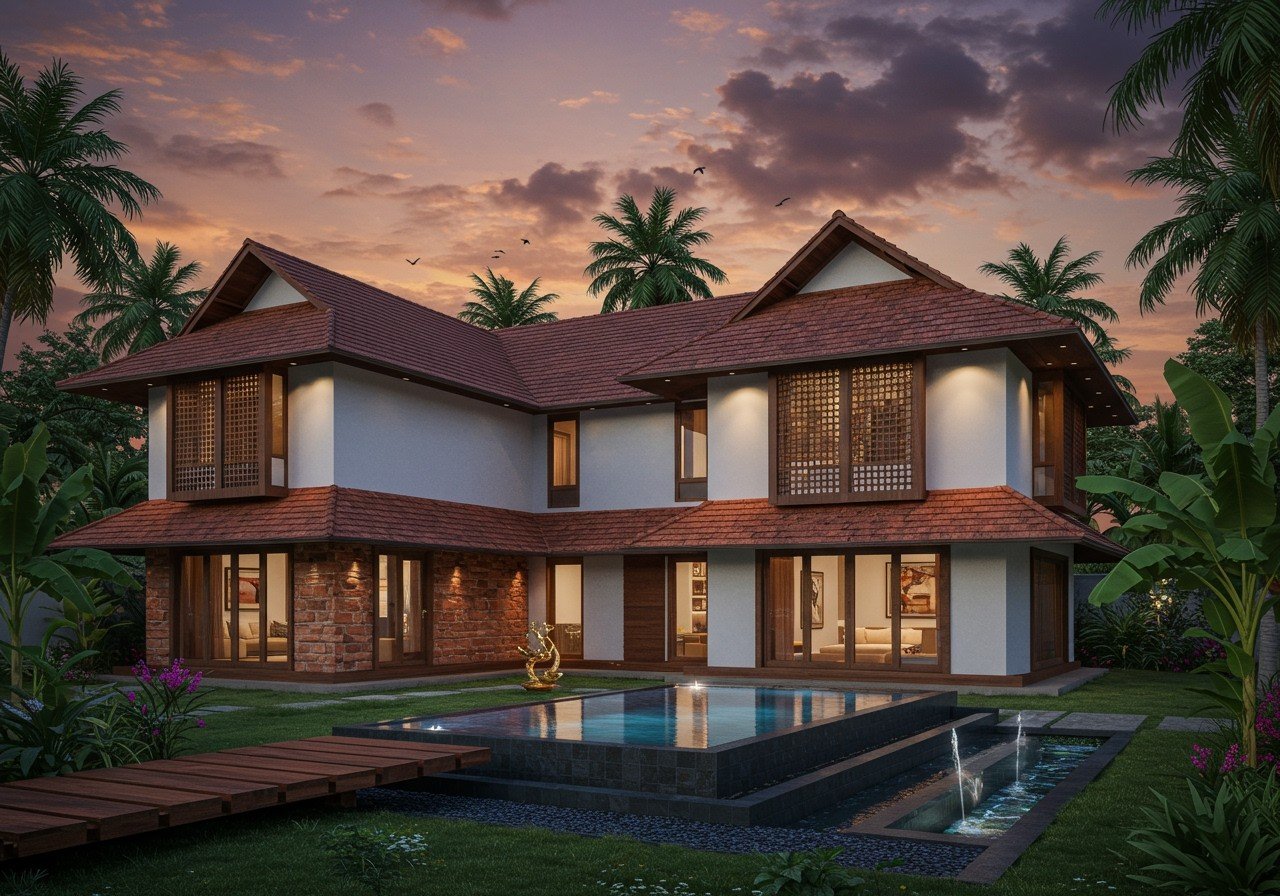
Kerala’s architectural landscape in 2025 is a captivating narrative of heritage meeting innovation. It’s a beautiful fusion of traditional elements with modern sensibilities, reflecting the cultural richness of Kerala while embracing contemporary lifestyles. This evolution in design showcases not just a change in aesthetics, but a deeper understanding of how we live and interact with our spaces.
Historical Influences Shaping Contemporary Designs
Kerala’s architectural heritage is deeply rooted in history. The iconic sloping roofs, intricate woodwork, and detailed carvings we see today are echoes of the past. Traditional ‘tharavadu’ homes and the unique ‘nalukettu’ layouts, with their central courtyards, serve as the foundation for modern interpretations. The colonial era also left its mark, introducing new materials and styles that have been seamlessly adapted into contemporary designs.
Defining Modern Kerala Architecture: Local Materials, Global Inspiration
What truly defines modern Kerala architecture is the thoughtful use of local materials like laterite and timber, combined with modern technology. This approach respects traditional design principles like ‘vastu shastra’, ensuring harmony and balance within the home. The emphasis on natural ventilation and open spaces not only enhances comfort but also fosters a connection with the natural world.
Current Design Trends in Kerala Homes
The year 2025 sees Kerala embracing minimalist aesthetics and the seamless integration of smart home technologies. Sustainability is a key focus, with eco-friendly practices like rainwater harvesting and solar energy becoming increasingly popular. Global design trends also play a role, adding elements like sleek glass facades and modular layouts that offer flexibility and functionality.
Cultural and Social Influences on Kerala Architecture
Kerala’s vibrant culture and social dynamics deeply influence its architecture. Communal spaces and courtyards encourage social interaction and the continuation of cultural practices. Skilled local artisans play a vital role, preserving traditional techniques while adapting them to meet modern needs.
Showcasing the Blend: Inspiring Case Studies
Several innovative Kerala house designs exemplify this harmonious blend of tradition and modernity. Residential projects are incorporating traditional elements like the ‘chuttu verandah’ alongside modern amenities, catering to the evolving lifestyle preferences of middle to upper-middle-class families. These designs showcase how tradition can be reinterpreted for contemporary living.
Navigating Challenges, Embracing Opportunities
Architects face the challenge of balancing tradition with modernity while navigating regulatory constraints and budget limitations. However, within these challenges lie opportunities for creative expression. Government initiatives are also playing a crucial role, supporting sustainable and culturally sensitive development.
Kerala House Design Trends in 2025
Kerala house designs in 2025 are experiencing an exciting evolution, blending classic charm with modern functionality. Here are some key trends:
- Sustainability and Eco-Friendly Materials: This includes using locally sourced materials like laterite stone, bamboo, and reclaimed wood. Green building practices, energy-efficient lighting, cooling systems, and eco-conscious paints are also becoming increasingly prevalent, reflecting a growing awareness of environmental responsibility.
- Minimalism Inspired by Kerala: This involves a calming blend of local heritage and contemporary design, featuring muted, earthy color palettes. Traditional textures like wood, cane, and rattan create a serene atmosphere. Clean lines, uncluttered spaces, and modern open layouts that adhere to Vastu principles are also hallmarks of this trend.
- Integration of Nature (Biophilic Design): This trend focuses on merging indoor and outdoor living spaces through elements like courtyards, open verandas, glass walls, skylights, and garden-facing lounges. Bringing nature indoors with plants, vertical gardens, natural stone, wood textures, and water features enhances the connection with the environment.
- Smart Homes: Integrating smart lighting, appliances, and home automation systems during construction allows for remote operation of appliances and security, adding convenience and efficiency to daily life. Modular kitchens and custom wardrobes are customized to meet individual needs.
- Flexible Spaces: Creating adaptable spaces like home offices, study nooks, meditation corners, and guest rooms using sliding dividers, fold-away furniture, and modular shelving units maximizes functionality and caters to evolving needs.
- Fusion of Traditional and Contemporary Architecture: This trend reimagines traditional elements like sloping tiled roofs and wood detailing in a modern context. Nalukettu-inspired layouts with central courtyards offer a blend of rustic charm and sleek, minimal interiors.
Traditional Puja Essentials for Your Modern Kerala Home
As you design your modern Kerala home, remember that Poojn.in offers a wide selection of puja essentials that beautifully complement both traditional and contemporary aesthetics. Whether you’re looking for an exquisite asanapattu (prayer mat) or handcrafted brass and copper puja items, we have everything you need to create a sacred space that resonates with your personal style and spiritual practice. For those seeking authentic Kerala-style prayer mats, Poojn.in provides a variety of designs, including rectangular, circular, and square shapes, to perfectly suit your puja room’s dimensions. We understand the importance of maintaining a sacred ambiance in your modern Kerala home. You can easily order these items from Poojn.in and have them delivered nationwide with secure packaging.
For product inquiries, feel free to contact us at 03369029784 or WhatsApp us at 9476142738.
Beautiful diyas enhance the spiritual atmosphere, and you can find authentic ones at Poojn.in. Kajal lata is also an essential part of a traditional puja set up.
Embracing the Future, Honoring the Past
Kerala in 2025 stands as a testament to the harmonious coexistence of tradition and modernity. This fusion isn’t just about architectural styles; it’s a reflection of a cultural ethos that values its heritage while embracing progress. Home designs honor time-tested principles while incorporating smart technologies and sustainable practices. This journey showcases the resilience and creativity of Kerala, where every home tells a story – a story of respect for the past and excitement for the future.
FAQs: Your Questions About Modern Kerala Architecture Answered
What distinguishes modern Kerala architecture? Modern Kerala architecture beautifully blends traditional Kerala styles with contemporary design elements. It utilizes local materials like wood and laterite while incorporating modern materials like glass and steel.
How does Kerala’s house design stand out from other architectural styles? Kerala architecture emphasizes natural ventilation, sloping roofs, and open spaces, creating a seamless connection between the living space and the natural world. This sets it apart from other styles that often feature closed, compact designs.
What is the significance of blending tradition and contemporary design in Kerala architecture? This fusion is vital for preserving cultural heritage while meeting the needs of modern living. It respects the past and embraces the present, resulting in functional and aesthetically pleasing homes for today’s lifestyles.


